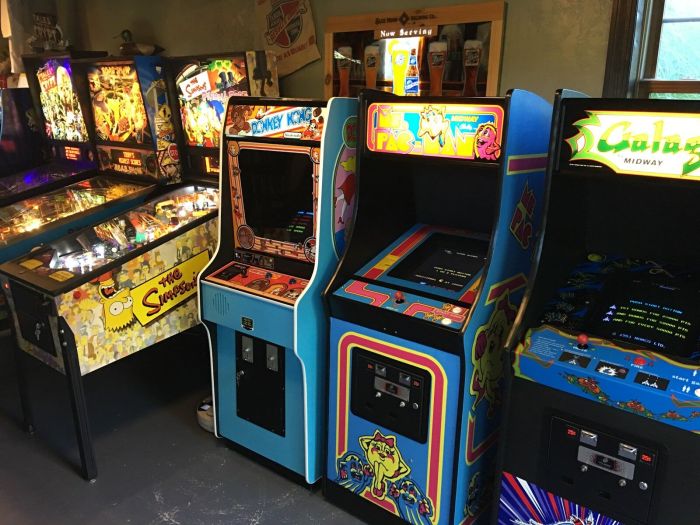Arcade games in pixels, a captivating realm where retro charm meets modern innovation, invite us on a nostalgic adventure through the evolution of gaming. From the iconic sprites of Pac-Man to the vibrant worlds of modern indie titles, pixel art has shaped the visual landscape of arcade games, leaving an enduring mark on our collective gaming experience.
As we delve into the world of arcade games in pixels, we’ll explore the technical limitations that gave rise to this unique art form, the creative solutions that pushed its boundaries, and the enduring legacy it has left on the gaming industry.
Arcade Games in Pixels: A Historical Perspective
![]()
The genesis of arcade games in the 1970s and 1980s was inextricably linked to the emergence of pixel graphics. These early games, such as “Pong” and “Space Invaders,” utilized rudimentary pixelated visuals to create simple but engaging experiences.
As technology advanced, pixel art in arcade games evolved significantly. Games like “Pac-Man” and “Donkey Kong” introduced more complex and colorful graphics, showcasing the potential of pixel art as a medium for storytelling and character design.
The limitations of pixel graphics also fostered creativity and innovation among game developers. They employed clever techniques, such as dithering and color cycling, to create the illusion of depth and texture, pushing the boundaries of what was possible with limited resources.
Technical Aspects of Pixel Art in Arcade Games
The technical constraints of arcade hardware in the early days of gaming had a profound impact on the development of pixel art. Games were typically limited to a small number of colors and low resolutions.
Despite these limitations, arcade game developers created visually appealing and iconic graphics. They utilized color palettes that were carefully chosen to maximize impact and readability, even on small screens.
The hardware capabilities of arcade machines also influenced the design of pixel art. The limited processing power meant that developers had to be efficient in their use of graphics, often creating characters and environments that were simple yet recognizable.
Aesthetics and Visual Style of Pixel Art in Arcade Games

Pixel art in arcade games possesses a unique visual charm that has endured over time. The simplicity and blocky nature of the graphics create a sense of nostalgia and retro appeal.
Pixel art allowed developers to create memorable characters and environments that are instantly recognizable. From the iconic Pac-Man to the lovable Donkey Kong, these characters have become synonymous with the golden age of arcade gaming.
The visual style of pixel art in arcade games varied depending on the hardware and artistic vision of the developers. Some games, like “Galaga,” employed a more realistic approach, while others, like “Bubble Bobble,” opted for a more whimsical and colorful style.
The Impact of Pixel Art on Arcade Game Design
The limitations of pixel art had a significant impact on the design of arcade games. Developers had to be creative in their approach to level design and gameplay mechanics to overcome the graphical constraints.
For example, in the game “Pac-Man,” the simple maze layout and limited enemy AI were necessary due to the hardware limitations. However, these limitations also contributed to the game’s addictive and challenging nature.
Pixel art also influenced the development of new gameplay mechanics. In the game “Donkey Kong,” the pixelated graphics allowed for precise platforming and puzzle-solving elements that would not have been possible with more realistic graphics.
Pixel Art in Modern Arcade Games

In recent years, there has been a resurgence of pixel art in modern arcade games. Developers have embraced the retro aesthetic and charm of pixel graphics, while incorporating modern technology to enhance the visual experience.
Contemporary arcade games like “Shovel Knight” and “Hyper Light Drifter” showcase the versatility of pixel art in creating visually stunning and engaging gaming experiences.
Modern arcade games utilize pixel art in innovative ways. For example, the game “Celeste” employs pixel art to create a beautiful and challenging platforming experience, while “Undertale” uses pixel graphics to tell a compelling and emotional story.
FAQ: Arcade Games In Pixels
What are the origins of pixel art in arcade games?
Pixel art in arcade games emerged in the early days of gaming, when hardware limitations restricted the use of high-resolution graphics. Developers turned to pixel art as a way to create visually appealing and recognizable characters and environments within these constraints.
How has pixel art influenced the gameplay of arcade games?
Pixel art’s limitations have had a profound impact on the gameplay of arcade games. The simplicity and clarity of pixelated graphics allowed for fast-paced, responsive gameplay, which became a defining characteristic of the genre.
Why has pixel art experienced a resurgence in modern arcade games?
Pixel art has seen a resurgence in modern arcade games due to its nostalgic appeal and its ability to evoke a sense of retro charm. Additionally, the simplicity and flexibility of pixel art make it well-suited for the limited resources often available in arcade environments.
